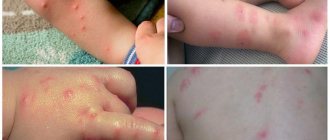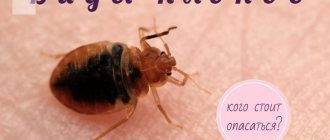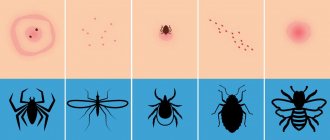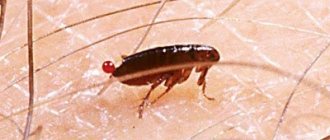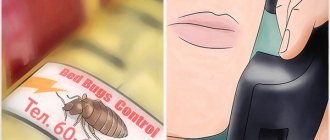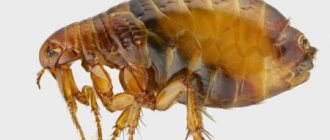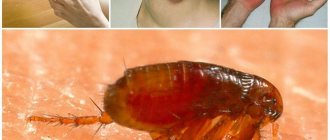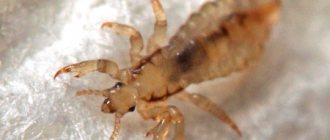It happens that at night someone begins to bite a person in his own bed. The first thought is: “Bedbugs!” Indeed, these harmful insects cause significant damage to both the physical and mental health of a person. If they multiply greatly, you can forget about normal sleep, and itching, redness of the skin and pain at the site of the bites will become familiar. But there are other insects that can bite in bed at night, besides bedbugs. There are quite a lot of such parasites, and the only good thing is that it’s easier to get rid of them, compared to bedbugs.
Blood-sucking bugs
Blood-sucking bedbugs are the only insects listed here that literally live in beds, sofas, bedding, and the folds of mattresses and pillows.
- The size of bedbugs most often varies between 5–7 millimeters, the bodies of females are rounded, those of males are more elongated, the color is brown, copper, or reddish-brown.
- The larvae look like smaller versions of adult bedbugs, but are lighter in color and smaller in size.
- Bed bugs leave behind a brown, corrosive dirt that is easy to find in places where insects accumulate.
- Bite marks look like swollen red dots, which always appear in several pieces and line up in a chain.
- When bugs puncture the skin, they inject an anesthetic into it, so the moment of the bite may not be felt; in larvae, this body system is underdeveloped, so their bites, on the contrary, can be painful.
In Moscow and the Moscow region, two types of bed bugs are found in apartments - bed
(Cimex lectularius) and
tropical ones
(Cimex hemipterus). If you do not take into account extreme situations, when the number of insects in the room is close to catastrophic, then bed bugs will bite mainly at night, tropical ones - during the day.
Recommended Links
The reasons for the appearance of bedbugs in the bed, methods of searching for them, characteristic signs of their presence and methods of destruction.
How dangerous is a bedbug bite for humans?
Why is a home bedbug bite dangerous for humans? It does not pose a serious threat, but it can cause physical discomfort and cause a person an enormous amount of moral suffering, even leading to a nervous breakdown. Women are very afraid of insects, and the very fact of the presence of some biting bugs in bed can lead to panic and hysteria.
Possible consequences of bites
- For some, small wounds itch slightly, and bedbug bites pass painlessly and unnoticed.
- Susceptible people scratch the damaged areas and lead the wounds to complications and abscesses.
- Of course, there is a small percentage of people who have an allergic reaction and it is quite serious. It can be expressed by a mild form of suffocation or cough. When the allergy is severe, it can end in anaphylactic shock, which is very dangerous.
Fleas
A person can be bitten by several types of fleas
and all of them are carriers of parasites and various diseases, from helminthiases to plague, borreliosis and various types of typhus.
- The size of fleas living in the Central region of Russia usually varies between 0.5–3 millimeters, so the insects look mostly like dark moving dots.
- A flea bite always feels like a sharp, burning pain at the site of the skin puncture.
- A small, hard, dried drop of blood may remain at the site of the bite.
- Insects are not particularly scrupulous in choosing a place on the body to feed on, so they can bite in any open areas of the skin.
- The flea bite begins to itch instantly and itch severely for several days.
Fleas do not tend to gather en masse to nest in a specific place, so they can live scatteredly anywhere in the house, not necessarily in or near the bed. If you suspect that it is fleas that are biting you, they live throughout the room.
Helpful advice
If you are not sure which insects are bothering you and the description of the nature of the bites still leaves you in doubt, if possible, try sleeping in different rooms and on different beds in the house and track how, when and where you do or do not get new bites. This way you can assess the scale of the problem and, perhaps, weed out several variants of pests using the process of elimination.
Determining who bites at night
To understand which parasites attack after sunset, you need to carefully study the signs of the affected areas of the skin and correlate them with the characteristics of the effects of different insects. Their lifestyle plays an important role. Of the parasites considered, bed bugs, mosquitoes and linen lice attack at night.
If bites appear only at night, and insects do not bother you during the day, then it can be said that the bed is infested with bedbugs.
Mosquitoes and linen lice can bite around the clock, however, the first of these parasites attack more often at night. Linen lice need food much more often, so they must feed every 3-4 hours. This means that traces of these insects appear during the day. House fleas only bite in the morning, so you shouldn't suspect them.
Interesting video: The most painful insect bites
Lice
Lice
provoke the development of pediculosis and can be carriers of typhus and relapsing fever.
- Depending on the type of lice, the length of their light, oblong or round bodies can range from 1 to 4 millimeters.
- Most lice live directly on a person and constantly feed on his blood; body lice can live in things or a room, but not very far from the food source - a person.
- Lice bites are not felt, but after some time, which depends on the individual characteristics of the body, they begin to itch.
- If there are a large number of pests, their bites may merge into single red spots on the skin and become covered with a white flaky crust.
If you suspect that there are lice at home, you should start looking for them not from the bed or room, but from your own body. Insects can live on the head, eyebrows, mustache, armpits, groin, any place where hair is longer than 2-3 millimeters. Body lice can also be found on fleecy fabrics, which are similar in structure to hair.
Basic solutions to the problem
If the causes of your insomnia and inflamed wounds are bedbugs or cockroaches, the entire apartment will require pest control. The same should be done in the case of fleas. But in addition, you will have to take your pets (if any) to the veterinarian for an examination.
In the next article we will tell you: Can bedbugs live in household appliances? In the TV, refrigerator, washing machine?
Pubic lice can be eliminated by removing hair from the area. To destroy ordinary lice and nits, special shampoos and masks are used. It will be difficult to get rid of mosquitoes once and for all. You will have to constantly use fumigators, cover the windows with nets and use special sprays or creams.
In any case, you need to immediately determine the type of insect that is keeping you up at night and get rid of it as soon as possible. After all, many of them are carriers of encephalitis, plague, anthrax, and typhoid. Not to mention that victims of parasites may suffer from allergies, constant thinness and discomfort.
Midges
Midges in the house can be understood as pests that, according to the official scientific classification, belong to this family
, and in general small flying insects, the species of which cannot be determined by eye.
- Carnivorous midges can either tear out pieces of skin and feed on them, or drink blood.
- The skin reaction to a midge bite can be different and depends on the type of parasite; sometimes it can be a rounded red micro-abrasion that does not cause any sensation, sometimes it can be intense redness, itching and swelling of the skin several centimeters in diameter around the site of damage.
- , the bite of midges
in the Central region of Russia is not felt by humans. - You don’t need to look specifically for midges; if they are found in your home, you can easily notice them swarming or flying near the food that interests them.
Not all midges bite; many of them feed on indoor plants, microflora growing in damp places at home, your food and pet food. These types of midges can and should also be combated.
Recommended Links
What kind of midges can live in apartments, where do they come from and how to get rid of them?
Mosquito bites
The mosquito bites unnoticeably, and we often notice this when the bite site begins to itch. Once the mosquito has tracked down the victim, it sticks with its proboscis to thin, well-circulating areas of the skin. Symptoms of mosquito bites:
- redness;
- itching;
- swelling;
- blisters.
Itching and redness appear a few minutes after the bite. If a blister forms at the puncture site, the surrounding skin swells and turns red.
Why do mosquitoes bite?
If someone bites you at night, especially in the summer, then most likely it will be a mosquito. They are especially active at dusk. The darkness does not prevent them from tracking down their prey. Carbon dioxide, which is released by a person when exhaling, helps to find it. Mosquitoes sense it at a distance of up to 50 meters.
Mosquitoes respond to heat and body odor. Therefore, the warmer the room, the more they bite. Mosquitoes select victims based on their characteristic odor; the more bacteria on the surface of the skin are involved in the formation of the odor, the higher the likelihood of a bite.
Mosquito bites - harmless or dangerous
The mosquito bites because it needs blood protein to produce eggs. When he bites, the immune system recognizes his saliva as a threat and releases histamine. Itching is an allergic reaction to the bite. It is usually harmless, but is annoying and bothersome. If you do not scratch the bite, the itching gradually decreases and after a few days there will be no trace of redness left. If the blister is scratched, the wound may become inflamed.
How to protect yourself from mosquitoes
Mosquitoes are summer companions, and it is impossible to completely get rid of them, but you can reduce the likelihood of bites. To do this, install mosquito nets on windows and doors. You can leave the air conditioner on as mosquitoes avoid cool air. Ultrasonic traps, fumigators, and spirals help fight them well.
If you prefer traditional methods, then place geranium flowers and peppermint on the window. You can treat the frames with tincture of wheatgrass and wormwood. Essential oils of clove, anise or tea tree repel mosquitoes.
Mosquitoes
Mosquitoes are a whole family of insects that feed on blood. They can enter your home through open windows and vents, through ventilation or drainage systems and are one of the most common pests in the warm season.
- Mosquitoes have dark gray bodies, up to 1 centimeter in length, and transparent wings located parallel to the body.
- Insects emit a characteristic monotonous squeak during flight, which is easy to hear if the parasite is hovering around your head.
- Mosquito bites are sometimes felt, sometimes not, it all depends on the individual sensitivity of the skin and where your attention is directed - most often, if people are passionate or busy with something, the moment of the bite goes unnoticed.
- The bite itself looks like redness that is dense to the touch, itches, and sometimes there is a small swelling around it, but in most cases it goes away after 1–4 hours.
Mosquitoes breed in water and places with high humidity, so they cannot literally live in your bed, however, it is more convenient for them to feed on your blood precisely while you are sleeping, so bites are often discovered in the morning.
How to find out if there are bed bugs at home.
Bedbugs are parasites of humans. They feed on blood. Unlike fleas, bedbugs usually bite at night, around 3-5 am. General characteristics of bedbugs:
- Reddish-brown color.
- 1 mm - 5 mm in length.
- Flat and adults look like an apple seed.
- Unlike fleas, bedbugs do not jump.
- Bed bugs move quite quickly up to 1 meter per minute.
- If you notice a flea and want to crush it, it will most likely jump away, but there is a chance of crushing a bug, although you also need to make an effort to catch it.
- Bedbugs, unlike fleas, do not jump or fly.
- Bedbugs feed at night; if there are a lot of bedbugs, they can bite during the day; there are also tropical bugs that bite around the clock.
- They get into the house in various ways: with things, from neighbors, you can see an article about this on the website
Cockroaches
Cockroaches may begin to bite if their population in the house lacks other food or it is out of reach, or if they have already become accustomed to feeding on human and animal tissue elsewhere and then crawled to you. In practice, this rarely happens yet, but you cannot completely exclude the possibility that it is cockroaches that bite you in bed.
- The sizes depend on the type of cockroaches
, their gender and stage of development; they can be from 1.5 to 6 centimeters in length, on average about 2.5–4 centimeters. - The color can be red, black, brown, copper or brown.
- When a cockroach bites, it tries to tear off a piece of skin from you, so the marks of these attempts look like superficial, ragged abrasions of any shape.
- Sometimes a cockroach does not have enough strength to tear off that piece of skin that it has coveted, then a piece of it remains next to the wound and gradually dries out.
- If you have sensitive skin, dark spots similar to bruises may occur at the site of the bites.
If your bites fit the description of cockroach bites, carefully inspect the entire room where you sleep, as well as the kitchen and bathroom. If you have cockroaches, you are likely to find them when examining them in dark and damp areas of the apartment.
Recommended Links
Why did cockroaches start biting people? How, when and why do they do it? What do these bites look like and why are they dangerous?
Lovers of human blood
The presence of blood-sucking parasites in an apartment not only gives its residents an unpleasant itchy sensation in the bitten areas, but can also cause sleep disturbances and even nervous disorders.
Interesting!
Statistically, bedbugs are a scourge in some European capitals such as London, Stockholm and Amsterdam, as well as major cities in the United States. The number of apartments in which blood-sucking insects have settled grows exponentially every year, which is why professional bedbug extermination services do not have time to fight them; moreover, the parasites have been able to develop resistance to most insecticides.
In addition to bed bugs, which are the most famous and widespread insects that love to feed on human blood, you can find other similar pests in nature that bite night and day.
Therefore, if someone wakes up in the morning and discovers that he has been bitten by invisible bugs, and he knows for sure that they cannot be in the apartment, then you can try to determine the type of “bloodsucker” by the appearance of the wound at the site of the bite. Below is a list of possible contenders, their descriptions and methods of struggle.
Hives
The harmless urticaria butterfly has nothing to do with it; we are talking about one of the types of dermatitis, whose manifestations are easily confused with insect bites. Urticaria is characterized by red, itchy blisters that resemble nettle burns, which is where it gets its name. Most often, the disease is of an allergic nature, but blisters can appear without an obvious reason one at a time, several at a time, or en masse at once.
The main difference that allows us to distinguish this form of dermatosis from insect bites is that urticaria leaves blisters with a uniform surface; there is no visible point where the bite was made. It may be difficult to see with the naked eye, but a magnifying glass and phone camera can help you enlarge the blisters to the required size and thus more accurately determine their origin.
Carefully!
Insect bites can cause an allergic reaction of varying severity and lead to infection with any infections and diseases. If, after discovering bites, your health worsens or you begin to notice any alarming, uncharacteristic manifestations in the functioning of your body, be sure to consult a doctor.
Allergies and skin diseases
Unfortunately, allergies have become one of the most common phenomena in the 21st century. Currently, there is a reaction to a variety of substances: food, household chemicals, cosmetics, animal hair, medications and much more. Including cold and sunlight.
Allergies have many symptoms and manifestations. These include skin that constantly itches and a persistent feeling that something is crawling on the body.
This pathology is accompanied by diseases such as skin dermatitis, urticaria, and dyshidrosis. All of them only aggravate the patient’s condition and go away when the allergy is completely cured.
Skin diseases that cause the feeling of crawling insects on the body include:
- scabies;
- psoriasis;
- dermatomycosis;
- ringworm and others.
Signs characteristic of allergic and skin diseases:
- various rashes and skin lesions;
- deterioration of health;
- often the presence of an already known allergen.
It must be emphasized that there are no purely skin diseases. The causes of these diseases may be hidden in disruption of the functioning of internal organs, weakening of the immune system, and the emergence of new types of allergens in the environment.
How to get rid of insects in bed?
To get rid of insects in bed:
- Unfold the sofa or bed, take out all the things from the drawers, remove the bedding.
- Carefully inspect each element separately for the presence of insects or traces of vital activity; it is most convenient to do this in daylight and using a flashlight.
- If you find pests, eggs or other signs of presence, take a vacuum cleaner with an empty dust bag and collect them, then remove the bag from the vacuum cleaner and dispose of it immediately.
The frame of a sofa or bed, storage boxes, slatted bottom and other structural parts of the sleeping place can be treated with insecticides in ready-made form against the type of pests that have settled in your home. Tools such as:
- Clean house
- Varan
- Combat SuperSpray
- Super cobra
- Dr. Klaus universal
- August Insecta
- Medilis-Superpower
- Raptor 17 types of insects
- Raid Lavender
- Universal crips
Use any product according to the instructions for its use. When handling, wear closed clothing, rubber gloves and a respirator to protect your respiratory tract.
Bedbug bites in children
Bedbug bites in children do not look too serious: slight redness and blisters dissolve quite quickly, the main thing is not to let the skin be scratched to avoid infection. The itching goes away and the child does not feel any serious discomfort. If the baby’s body is too susceptible, complications arise in the form of:
- lymph nodes become inflamed;
- an allergic reaction flares up;
- temperature rises;
- headache appears;
- digestion is upset;
- Infection of damaged skin occurs.
These symptoms appear quite rarely. The main discomfort is psychological. Bite-bitten children do not have the opportunity to sleep soundly and normally; this makes them capricious and nervous, which affects the morale of not only the children, but also the parents.

